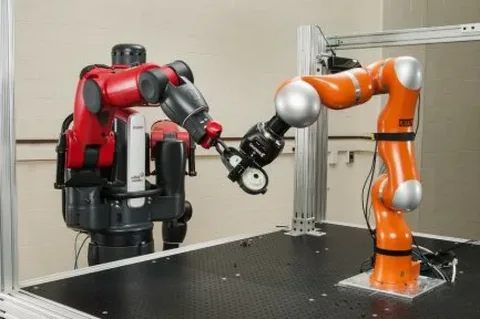
The global collaborative robots market is forecasted to grow at a rapid pace, with a compound annual growth rate (CAGR) of 25.1% during the forecast period. In 2023, the market is valued at USD 2.2 billion and is expected to reach USD 20.5 billion by 2033.
The integration of robots into industrial operations has also significantly reduced workplace accidents and improved product quality, driving demand across various industries. Retailers and e-commerce giants are increasingly investing in robotic technology to optimize their logistics and supply chain operations, utilizing cobots to support warehouse workers. The rising demand for cobots in the logistics sector is anticipated to offer lucrative growth opportunities over the forecast period.
The potential to enhance safety for workers is a key factor driving the sales of collaborative robots (cobots). Additionally, cobots are valuable in managing supplies needed for remote work and home learning setups. The advent of 5G technology is also expected to accelerate the adoption of cobots in the industrial sector. For instance, Nokia Corporation has introduced an industrial-grade 5G wireless network designed to meet the requirements of Industry 4.0. The low-latency connectivity provided by 5G is projected to help original equipment manufacturers (OEMs) improve robotic automation and boost the productivity, quality, and efficiency of manufacturing operations.
According to the International Organization of Motor Vehicle Manufacturers (OICA), China led the global motor vehicle manufacturing market in 2021, producing over 26 million automobiles and commercial vehicles, a figure substantially higher than the combined output of other countries.
However, the high initial costs associated with acquiring, integrating, programming, and maintaining cobots, along with the need for accessories, may hinder market growth. Additionally, a shortage of skilled personnel in undeveloped and developing regions poses a significant challenge to the expansion of the market.
Exhaustive Market Report: A Complete Study
Key Takeaways:
- The United States is expected to hold a large share of the global collaborative robots market over the projected period. Industrial collaboration robots, or cobots, are being used in the operations of businesses of all kinds across the country. This enables them to reduce labour costs, increase production, and improve quality.
- Asia Pacific collaborative robots market, driven by China and South Korea, is predicted to be significant over the forecast period. The expanding consumer preference for automation, artificial intelligence, and the emergence of other necessary technology presents considerable growth opportunities for the area.
- Owing to its increasing use in extremely labor-intensive applications in the automotive, electronics, chemicals, and semi-conductor sectors to handle large, costly, and delicate materials in order to minimize labour costs, the “material capacity” application type is expected to hold the prominent revenue, through the forecast period.
- As the demand for electronic components and semiconductors is increasing rapidly across consumer electronics, the “electronic & semiconductor” end user type, and is the most creative segment for key companies, accounting for a sizable portion.
Competitive Landscape:
Owing to the existence of both foreign and local rivals, the global collaborative robots market share is fragmented. Many companies have a substantial market share in their respective businesses. Organic advances, such as product approvals and the incorporation of artificial intelligence (AI) and machine learning (ML) technology in industrial robots, are commonly valued by large corporations. These factors are anticipated to very certainly drive the global collaborative robots market ahead.
Key Players:
- Universal Robots A/S
- AUBO Robotics
- Fanuc Corporation
- Stäubli International AG
- Robert Bosch GmbH
- KUKA AG
- Precise Automation Inc.
- Denso Wave Incorporated
- ABB Group
- Yaskawa Electric Corporation
- K2 Kinetics
Recent Developments:
- In May 2019, the Saudi government declared a US$ 30 billion investments to enhance warehousing facilities through the deployment of advanced autonomous robots in newly built warehouses across Saudi Arabia, consequently contributing to the growth of the cobots market in this region during the forecast period.
- In October 2019, the South Korean government pledged a US$150 million commitment to build intelligent robots for diverse industrial applications such as warehousing and logistics, therefore accelerating the expansion of the cobots industry.
Key Segments Profiled in the Collaborative Robots Market Survey
By Payload Capacity:
- Up to 5kg
- 5 to 10 kg
- Above 10 kg
By Application:
- Welding
- Material Handling
- Quality Testing/Inspection
- General Assembly
- Painting/Spraying
- Others
By End Use:
- Automotive & Transportation
- Electronics & Semiconductors
- Food & Beverage
- Chemical & Pharmaceutical
- Logistics
- Healthcare
- Others
By Region:
- North America
- Latin America
- Asia Pacific
- Middle East & Africa (MEA)
- Europe
About Future Market Insights (FMI)
Future Market Insights, Inc. (ESOMAR certified, recipient of the Stevie Award, and a member of the Greater New York Chamber of Commerce) offers profound insights into the driving factors that are boosting demand in the market. FMI stands as the leading global provider of market intelligence, advisory services, consulting, and events for the Packaging, Food and Beverage, Consumer, Technology, Healthcare, Industrial, and Chemicals markets. With a vast team of over 400 analysts worldwide, FMI provides global, regional, and local expertise on diverse domains and industry trends across more than 110 countries.
Contact Us
Future Market Insights Inc.
Christiana Corporate, 200 Continental Drive,
Suite 401, Newark, Delaware – 19713, USA
T: +1-845-579-5705
For Sales Enquiries: sales@futuremarketinsights.com
Website: https://www.futuremarketinsights.com
LinkedIn| Twitter| Blogs | YouTube

